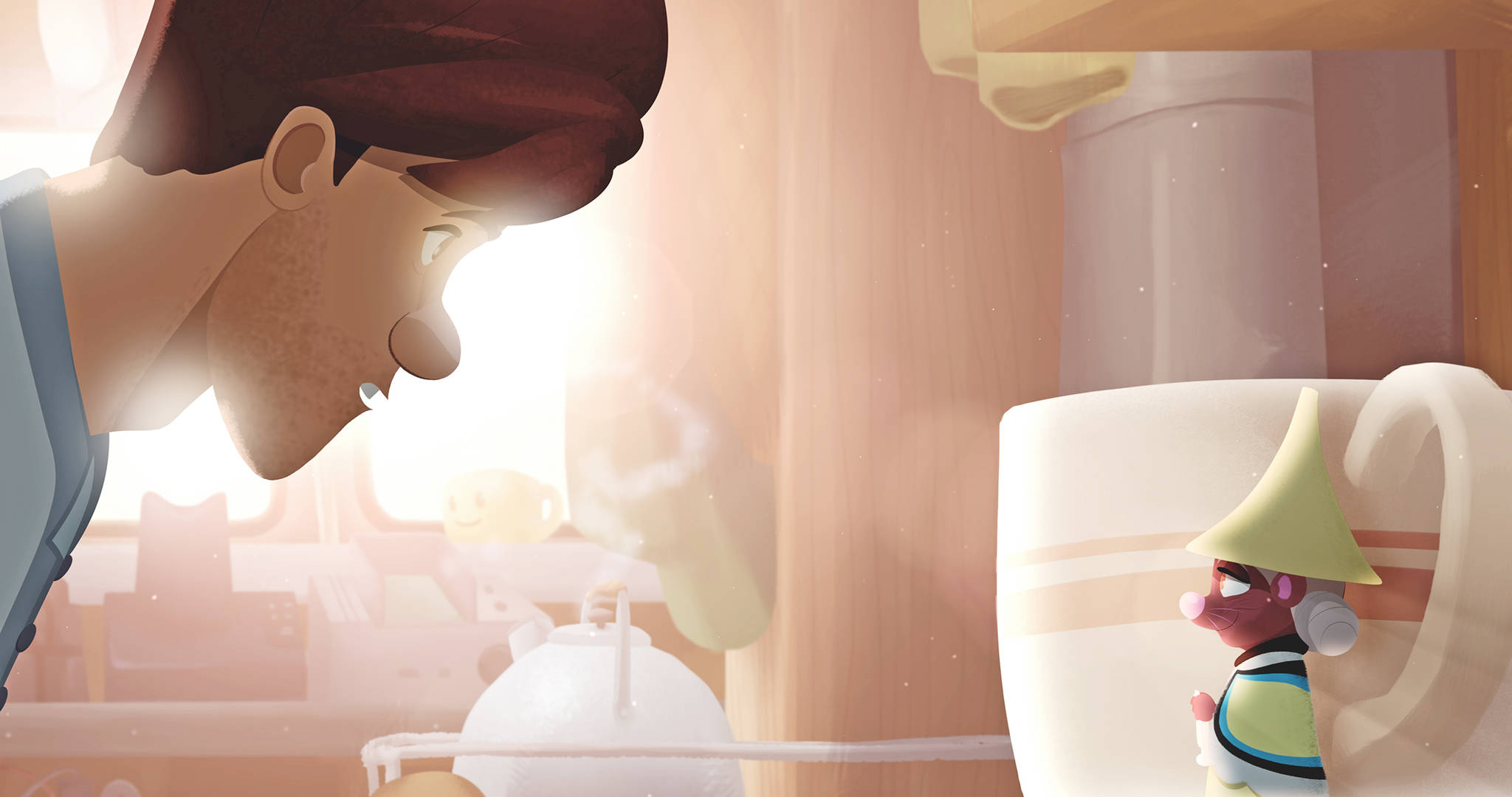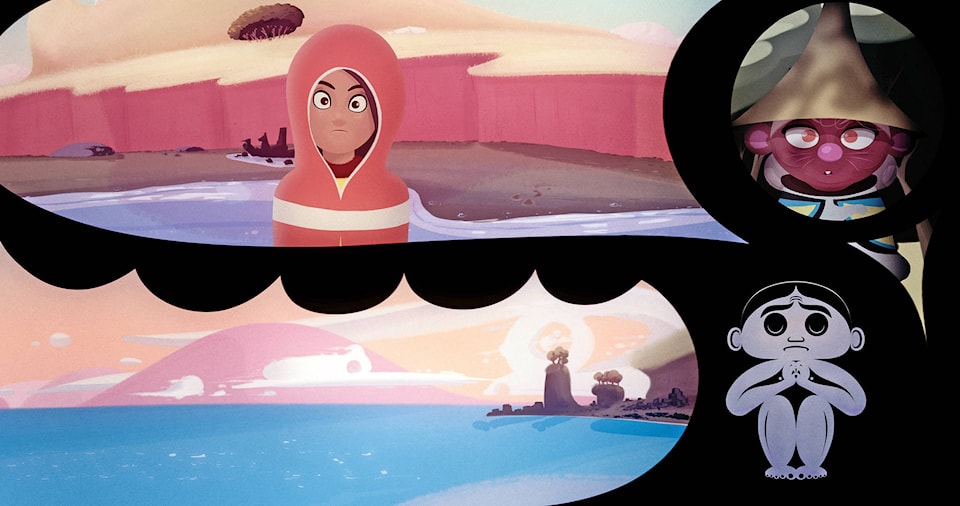Cruising to fish one morning on the Silver Shadow, a bored skipper zones out in the glow of his cellphone.
The radio crackles, his tea kettle stirs, and a mouse dressed in Haida regalia hops out from his tea cup with a ball of yarn.
Mouse Woman taps one knitting needle on a can of milk to get the skipper’s wide-eyed attention, but she doesn’t say a word.
Instead, her paws whir as she quickly knits him a blanket that tells the story of Kuuga Kuns, who dove deep into the ocean to rescue her beloved Naa-Naa-Simgat from the undersea mountain where he was taken by a great killer whale.
The Mountain of SGaana (Trailer) from NFB/marketing on Vimeo.
Written and directed by Haida animator Christopher Auchter, The Mountain of SGaana is a 10-minute film that contains a world of Haida story, and its only words are in Haida song.
Without spoken words, Auchter says, language isn’t a barrier.
“It could really do what I was hoping the film could do — travel the world so that other people could see the beauty of our stories.”
Speaking from Vancouver, where the film is now showing at the Vancouver International Film Festival (it’s also set for at least two screenings on Haida Gwaii), Auchter said he did plan to have Kuuga Kuns speak when he first started writing the film nearly three years ago.
But when National Film Board producers Michael Fukushima and Shirley Vercruysse suggested he try a wordless script, Auchter jumped at the idea.
“It was a really good challenge as a storyteller,” he said.
Judging by its first award, The Mountain of SGaana is visually clear and fun to watch, too — two weeks ago, a jury of school kids chose it for Best Animated Film for Young Audiences Ages 6 to 12 at the Ottawa International Animation Festival.
As it happens, that’s about how old Auchter was when he first heard the story of Mouse Woman, one of his favourite Haida characters.
He was in Grade 3 in Queen Charlotte, and a substitute teacher read the story, or started to.
“When the bell rang, the story never did get finished,” he said.
The next day, another teacher read another story, and he never heard the end.
“Maybe it was better that I didn’t know, because it allowed my imagination to keep going,” he said.
Auchter would go on to learn media arts at Emily Carr, and computer animation at Sheridan College. The first NFB short he worked on was Daniel Janke’s How People Got Fire, which tells a Tlingit story, and besides animating characters in Nintendo and Electronic Arts videogames, he created shorts for the APTN children’s series Tansi Nehiyawetan.
But everything Auchter needed to create The Mountain of SGaana, he learned from Haida Gwaii.
The Silver Shadow was his grandfather Bruce Hageman’s fishing boat, and starting just before high school, Auchter joined him as a deckhand for seven summers.
“Some of the best times of my life were spent on that boat with him,” he said.
Only when he started doing research for the film did Auchter realize the Bill Reid pole at the Haida Heritage Centre actually shows characters from the Naa-Naa-Simgat story.
Once he found out, he asked his mother Tracey Auchter to go photograph it from all sorts of angles.
“I always looked at that pole, my whole life growing up,” he said. “The story I’m telling now was right in front of me all those years.”
In Auchter’s telling, the story is flipped so that it’s Kuuga Kuuns, not Naa-Naa-Simgat, who braves the sgaana and rescues her lover from transformation into a supernatural (In Haida language, sgaana means both “killer whale” and “supernatural”).
And in the film, it’s his sister Nikita who actually signs Kuuga Kuns’ three Haida songs. One song was given to the Yaghulaanas clan by a rescued shark. Another is a comforting lullaby sung in a storm, and the third was written as a song of thanks by a nearly-drowned man (it proves very good at keeping Kuuga Kuns out from the soup of a giant halibut).
“I didn’t know she could sing like that, and I’m not even sure my parents knew,” Auchter said. In fact, he and Nikita kept her singing a secret right up until the day their parents finally saw it. It was quite a surprise.
“Nikita kept that concealed from all of us all these years.”
Even the small characters in Auchter’s film are ones people here will recognize.
Good-For-Nothing Marten slinks alongside Kuuga Kuns on her journey, just as a shadow followed Auchter the summer he and his uncle Michael Nicoll Yahgulanaas worked as Haida Watchmen at SGaang Gwaay.
“There were these three mornings in a row that I got up super early and I thought, ‘Oh, I’ll just go for a walk along the boardwalk to the village there, Ninstints.’”
“I could see this shadow underneath my feet on the boardwalk, and every time I reached the stairs I could see a little bit more — just this quick little shadow glimpse.”
On the third day, the shadow got the best of him, and Auchter stopped to peek under the boardwalk. The creature darted off across a tree, and never appeared again.
Yaghulaanas suggested it was Good-For-Nothing Marten, and even threatened to make that Auchter’s Haida name.
To tell a story that could easily fill a feature film in 10 short minutes, Auchter sometimes uses split frames.
When the bored skipper on the Silver Shadow first appears, the frames are straight and black.
But as Mouse Woman tells him the story, the frames not only take on her shape, but also the shape of Haida formline.
“I was giving a little nod of my cedar hat to my Uncle Mike,” he said, laughing. “He does that with his beautiful graphic novels.”
As in the original Haida story, when Kuuga Kuns and Naa-Naa-Simgat are finally reunited, they return to find that time has passed super quickly in the supernatural world.
In Auchter’s telling, they actually arrive in present day, in a canoe by the Silver Shadow.
“I just liked the symbolism of that,” he said.
“Haida culture is not gone, it’s not just in the past,” he said. “It’s here in the present — we’re trying so hard to revitalize our language, and young people are taking action.”
When the young skipper finally throws a tow line from the Silver Shadow to the Haida canoe, Auchter said, he’s pulling that culture closer.

